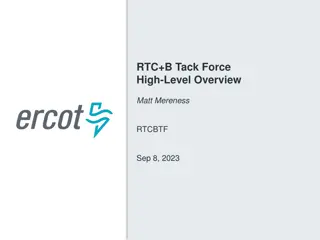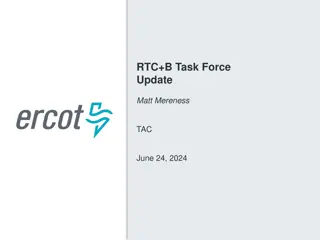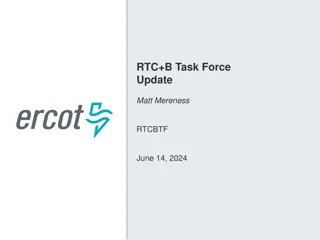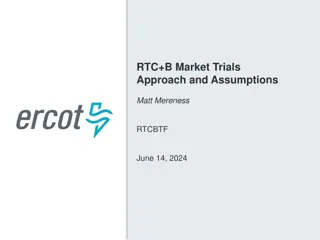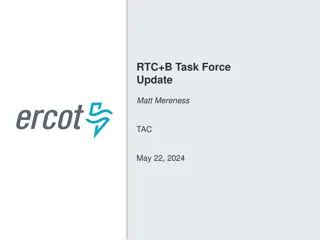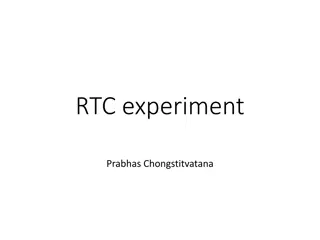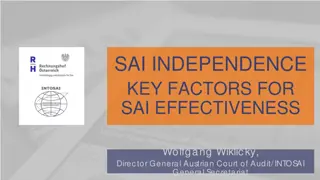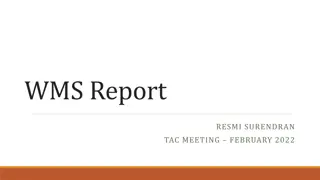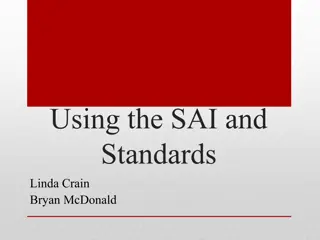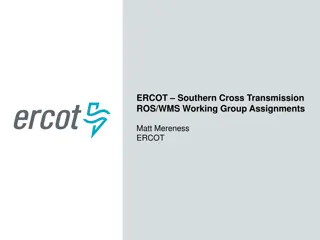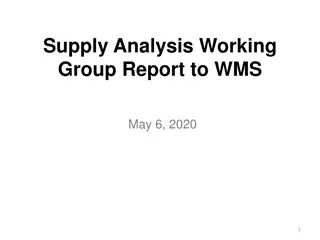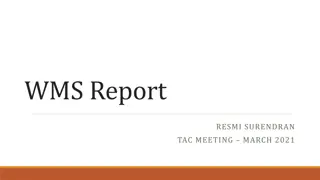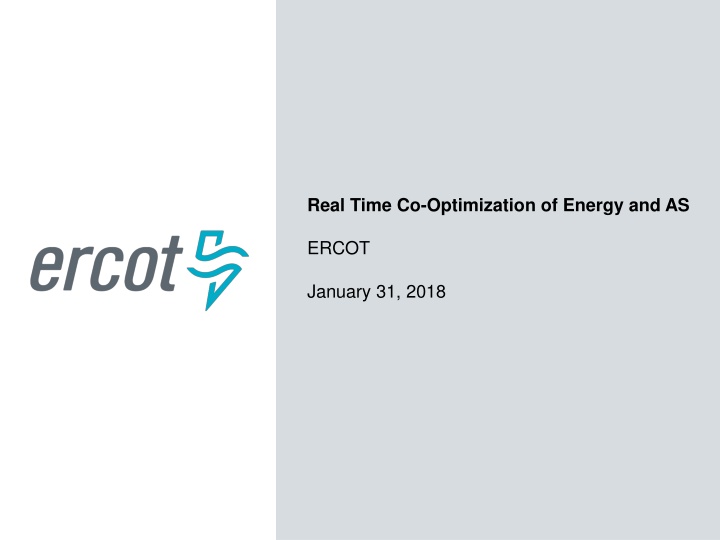
Real Time Co-Optimization of Energy and Ancillary Services in ERCOT Market
Explore the real-time co-optimization of energy and ancillary services in the ERCOT market, including procedural history, project assessments, and impacts on LMP. Learn about RTC's role in optimizing energy and AS provision, different from the current ORDC setup, with coordination and pricing insights.
Download Presentation

Please find below an Image/Link to download the presentation.
The content on the website is provided AS IS for your information and personal use only. It may not be sold, licensed, or shared on other websites without obtaining consent from the author. If you encounter any issues during the download, it is possible that the publisher has removed the file from their server.
You are allowed to download the files provided on this website for personal or commercial use, subject to the condition that they are used lawfully. All files are the property of their respective owners.
The content on the website is provided AS IS for your information and personal use only. It may not be sold, licensed, or shared on other websites without obtaining consent from the author.
E N D
Presentation Transcript
Real Time Co-Optimization of Energy and AS ERCOT January 31, 2018
RTC Procedural History Initial white paper in late 2014 with discussions at SAWG throughout 2015 White paper last updated in February 2016 Includes two high level approaches Requires further stakeholder input and decisions Worthwhile to provide an RTC review given the time that has passed 2 PUBLIC
RTC Procedural History Project 47199 Project To Assess Price-Formation Rules In ERCOT'S Energy- Only Market Many Stakeholders have filed comments regarding issues on price formation in ERCOT RTC is one of the issue they have opined on ERCOT updated the project regarding a Local Reserve Product as part of RTC in comments filed 9/29/17 ERCOT updated the project regarding RTC Cost Benefit studies in comments filed 12/7/2017 Project 41837 - PUCT Review of RTC in the ERCOT Region Update on ERCOT and Stakeholder Activities Related to RTC was filed 7/14/2017 Provides a high level RTC activities summary Discussion on coordination of the VOLL, SWOC, and Max value on the Ancillary Services Demand Curves Update on the RTC Cost and Time Estimates RTC Cost Benefit Studies The IMM and ERCOT are working together to simulate the introduction of RTC in historical Security Constrained Economic Dispatch ("SCED") cases. Estimated to be complete in 6 months (June 2018). ERCOT is analyzing improvements that RTC could have on the RUC Optimization. ERCOT is conducting an assessment of the effect that the existence of RTC may have on historical SASM activity 3 PUBLIC
Impacts of Ancillary Service Capacity (Reserves) on LMP (from PJM education materials) Regardless of methodology, reserves and energy come from the same supply pool. Allocating portions of the supply pool to each requirement will, at times, impact the marginal clearing price of both. In general, allocating resources to energy and reserves must be done SIMULTANEOUSLY to minimize the impacts of one product on the other in order to globally minimize the cost of both. If allocating resources to energy and reserves is done sub- optimally, the impacts of one product on another will be overstated. i.e. when required Ancillary Services and energy are not procured simultaneously 4 PUBLIC
What is RTC and How does it Differ from the Current ORDC? RTC allows for the optimal coordination of the provision of energy and AS among all resources in the real-time market and, similar to the current ORDC, the pricing of AS shortages in accordance with defined AS demand curves Unlike the current ORDC, a demand curve for each ancillary service would be applied within the SCED engine to allow SCED to internally optimize the provision of energy and AS among all resources, subject to each resources capabilities and offers AS capacity is no longer blocked from SCED by the HASL Establishes offer-based prices for AS capacity and energy in the real-time market through SCED under normal operating conditions, and under AS shortage conditions in accordance with the defined AS demand curves 5 PUBLIC
Key Changes Associated with the Implementation of RTC The pricing of operating reserve shortages as a function of VOLL and LOLP under RTC is generally consistent with the approximation achieved under ORDC B+ The following represent key changes associated with RTC beyond ORDC B+: 1. Least cost provision of energy and ancillary services 2. Potential reduction in RUC and SASM activity 3. Reduced risk and increased opportunity for resources 4. Fewer manual processes by ERCOT operators 6 PUBLIC
1. Least-cost Provision of Energy and AS Real-time conditions often vary from the day-ahead and can change the resources that are optimal to provide energy and AS For example, a transmission constraint could bind in the RTM and cause a resource selected in the DAM to provide AS to be more economic in real-time to provide energy than reserves RTC would automatically shift the AS from the resource in the constrained area to a resource outside the constrained area in a manner that is economically advantageous to both resources, and benefits loads by selecting the lowest cost resources to provide energy and AS Can also provide reliability benefits compared to the current market design when AS capacity in an import-constrained area may prevent access by SCED to energy required for congestion relief 7 PUBLIC
2. Potential Reduction in RUC and SASM Activity Implementation of RTC would also include modifications to the RUC engine, such that the ability to coordinate the provision of energy and AS among resources in the RTM would be recognized in RUC Compared to the current market, offers the potential to reduce RUC activity, particularly in broader import- constrained areas SASM activity would be reduced due to the coordinated access to the ERCOT portfolio of resources for the provision of energy and AS in RT 8 PUBLIC
3. Reduced Risk and Increased Opportunity for Resources Access by individual resources to the ERCOT portfolio of energy and AS in real-time Less SASM activity and access to the ERCOT portfolio of energy and AS in real-time results in less financial risk compared to current SASM process Increased opportunity for individual resources to economically optimize the provision of energy and AS in the real-time market 9 PUBLIC
4. Fewer Manual Processes by ERCOT Operators Automated identification and resolution of infeasible AS Automated release of AS capacity to provide energy during AS shortage conditions Reduced RUC recommendations and SASM activity 1 0 PUBLIC
Consideration of Locational Reserve Requirements in RTC ERCOT historically and currently has only system-wide AS requirements The current RTC white paper does not address the possible inclusion of AS with locational requirements and associated locational AS demand curves Based on recent discussions, it is anticipated that there will be further examination of the possible need for locational AS requirements and the manner in which those potential requirements would be incorporated into RTC 1 1 PUBLIC
Regulatory Changes Associated with the Implementation of RTC The current RTC white paper identifies the need to coordinate the system-wide offer cap and the maximum value of the AS demand curves in RTC Proper coordination of these values require resolution through possible changes to PUCT Subst. R. 25.505 12 PUBLIC
General Concerns Associated with the Implementation of RTC The costs that will be incurred by ERCOT The costs that will be incurred by market participants The time and resources associated with implementation and potential competition with other projects Some stakeholders have expressed concerns that introducing additional efficiency-enhancing measures such as RTC into the market may be detrimental to longer-term market policy objectives 13 PUBLIC
Links to Relevant Documents May 8, 2017 SAWG Need to co-ordinate values on VOLL SWOC PBPC training: http://www.ercot.com/content/wcm/key_documents_lists/118092/RT_Co- Opt_Coordination_of_VOLL_SWOC_PBPC.pptx July 14, 2017 SAWG Scarcity Pricing Examples under RTC - Spreadsheet RT Co Optimization Scenario Automated September 18, 2017 SAWG RTC White paper (Updated) http://www.ercot.com/content/wcm/key_documents_lists/131797/RT_Co- optimization_Scope_UPDATED_09292017.docx 14 PUBLIC

